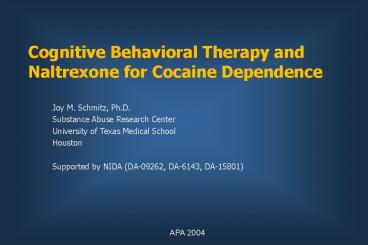Pharmacological Adjuncts for Use in Smoking Cessation - PowerPoint PPT Presentation
1 / 25
Title:
Pharmacological Adjuncts for Use in Smoking Cessation
Description:
Why Combine Behavior Therapy and Medication? ... Treatment integrity measures showed evidence of therapy adherence and discriminability. ... – PowerPoint PPT presentation
Number of Views:43
Avg rating:3.0/5.0
Title: Pharmacological Adjuncts for Use in Smoking Cessation
1
Cognitive Behavioral Therapy and Naltrexone for
Cocaine Dependence
- Joy M. Schmitz, Ph.D.
- Substance Abuse Research Center
- University of Texas Medical School
- Houston
- Supported by NIDA (DA-09262, DA-6143, DA-15801)
APA 2004
2
Why Combine Behavior Therapy and Medication?
- For the treatment of cocaine dependence, little
benefit from pharmacotherapy or psychotherapy
alone - Each form of treatment may address distinct
symptom areas, providing broader coverage - Offset the potential drawbacks associated with
either treatment - Patient heterogeneity leads to differential
response to treatment
3
(No Transcript)
4
Study Design
Pharmacotherapy (Naltrexone)
50 mg
0 mg
Drug Counseling (DC)
Psycho- Therapy
Relapse Prevention (RP)
5
Pharmacotherapy
- Naltrexone
- Opiate antagonists attenuate cocaine's euphoric
effects (Bain Kornetsky, 1986 Kosten et al.,
1992 Hubbell Reid, 1995 Reid et al., 1993
1996) - Opiate antagonists decrease cocaine
self-administration (DeVry et al., 1989 Mello et
al., 1990 Ramsey vanRee, 1991 Corrigall
Coen, 1991 Reid et al., 1995 1996 1997) - Opiate antagonist treatment associated with lower
rates of cocaine use (Kosten et al., 1989 Rosen
Kosten, 1991)
6
Psychotherapy
- Relapse Prevention (RP)
- Coping Skills Relapse Prevention Theory (Marlatt
Gordon, 1985) - Components include functional analysis of
situational factors associated with craving or
drug use, self-monitoring and specific home
practice exercises, general lifestyle
modifications, handling a lapse training.
- Drug Counseling (DC)
- General education, nondirective support,
encouragement for abstinence-oriented behaviors
(Woody et al., 1983 Luborsky et al., 1982) - Components include assessment of problem areas
(e.g., health, family, vocation), education about
recovery, crisis management.
7
Therapy Adherence
8
(No Transcript)
9
Retention
Log Rank Statistic 1.72, df 3, p .63.
10
Cocaine Use
Therapy x Medication x Time F (2, 60) 3.69, p
lt 0.03.
11
Does homework compliance predict outcome?
- Cognitive-behavioral psychotherapies are based on
the premise that clients are more likely to
improve if they apply skills learned in treatment
to situations outside treatment (i.e., homework).
- The relationship between homework compliance and
treatment outcome is reliable and robust across
different client problems (Kazantzis et al.,
2002).
12
CBT Homework
- Examples
- Self-monitoring
- Trigger sheet
- Recognizing assertiveness
- Goal setting
- Coping records
- Awareness of problem thinking
13
Motivation and homework completion on cocaine use
during treatment
14
Conclusions
- In cocaine-dependent patients, the combination of
naltrexone 50 mg and Relapse Prevention therapy
was effective in reducing cocaine use. - Treatment integrity measures showed evidence of
therapy adherence and discriminability. - For CBT, a positive relationship between
homework compliance and cocaine outcome was
found. Motivation to change affected the
direction of this relationship. - Need to replicate and extend to determine the
robustness of this treatment.
15
Naltrexone Studies
- Naltrexone and relapse prevention treatment for
cocaine-dependent patients - Naltrexone and relapse prevention treatment for
cocaine-alcohol dependent patients
16
Study Design
Pharmacotherapy (Naltrexone)
50 mg
0 mg
Drug Counseling (DC)
Psycho- Therapy
Relapse Prevention (RP)
17
TABLE 1 Characteristics of Participants in Each
Treatment Group
a Attended at least six weeks of treatment.
18
Retention
Log Rank (df 3) 3.62, ns.
19
Cocaine Use
Time x Therapy F (11, 332) 2.09, p lt 0.02.
20
Conclusions
- Naltrexone did not reduce cocaine or alcohol use
in this sample of dually-dependent patients. - Patients receiving Drug Counseling used less
cocaine over time than those receiving Relapse
Prevention. - Naltrexones lack of efficacy in treating this
type of comorbidity, also reported by Hersh et
al., 1998, may be due to greater impairment in
this population.
21
Combined Treatment for Cocaine-Alcohol
Dependence R01 DA15801
Pharmacotherapy (Naltrexone)
100 mg
0 mg
Relapse Prevention (RP)
Behavior Therapy
RP Conting. Manag. Proc
22
Results cocaine abstinent Ss
Pettinati et al, 2004
Men
23
Conclusions
- Among cocaine dependent patients
- Naltrexone 50mg
- reduced cocaine use
- was well tolerated
- worked best with CBT
- Among cocaine-alcohol dependent patients
- Naltrexone 50 mg
- ineffective with/without CBT
24
Future Considerations
- Optimal dosing
- Combination pharmacotherapy
- Relapse prevention vs abstinence initiation
- Enhancing compliance, increasing motivation
- Patients conceptualization of behavior therapy
medication
25
Treatment expectancies































